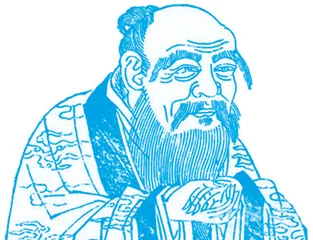“道”与物理学Dao and Physics
作者: 林巍/译

When I lectured Lao Zi at universities in the West, one of the most difficult things was to explain the concept of Dao to my students, given its ubiquitous and yet invisible nature. However, it may not be that difficult if we can relate it to some of the fundamentals in modern physics.
我在西方大学讲老子时,最难解释的是“道”。它看不见,摸不着,却又无处不在1。然而,若与现代物理学研究的某些基本知识结合起来,似乎又不太难理解。
Lao Zi hypothesized: “All things in the cosmos are generated from being and being arises from non-being”; “Dao produces one, one produces two, two produce three and three yield everything on earth”. Stephen Hawking, the British scientist, has theorized that time began with the Big Bang, originating from nothing. According to the theory of modern quantum cosmology, the observable universe is in that empty space where energy is at its lowest (or “ground”) state, formulated as a “constant quantity”, but certainly not below zero in light of the “uncertainty principle” of quantum mechanics.
老子说:“天下万物生于有,有生于无。”“道生一,一生二,二生三,三生万物。”根据英国科学家霍金的研究2,时间是从“宇宙大爆炸” 开始的,在此之前是空白;现代量子宇宙学也断言,“观测宇宙始于真空”。所谓“真空”,是系统的最低能量态(基态),特别是,依照量子理论中的“测不准原理”3,真空中的能量并不等于零,而是形成某一常量4。
Also, Lao Zi said, “All things under heaven are manipulated by Dao, in the same way as all streams and torrents flow to rivers and seas”. By assembling in the sea, all rivers actually make a “field of Dao”, where energy at high levels will naturally fill the void (ground state), which very much resembles a vacuum cavity in modern quantum field theory.
老子又说:“譬道之在天下,犹川谷之于江海。”而百川归海便形成一种“道场”——在场里较高的能态都会自发地趋向基态(真空态) ,非常近似于现代量子场中的“真空场”。
Such a so-called vacuum is in fact full of fleeting virtual particle pairs, such as a “virtual electron pair” made up of a virtual electron with a positron, floating within a “vacant space”. These particles, characterized by their transient nature, are hardly detectable even with the most sophisticated instruments, according to the “uncertainty principle” proposed by Heisenberg.
其实,真空不空,因真空中充满了无数倏忽产生又倏忽消失的“虚粒子对”,故曰“虚空”5,如“虚电子对”就是一个虚的电子加上一个虚的正电子。所谓“虚”,是指这些粒子生成的时间非常短暂,受到海森堡“测不准原理”的限制,因此原则上不可能用任何精密仪器直接探测其存在。
Quantum-mechanical research reveals that in any microcosmos we cannot point out exactly where electrons will appear, except calculating their probability as “material particles” drifting in a certain space at a certain time, which is very much in line with Lao Zi’s conceptualization: “Shapeless shapes are called vague resemblances—going towards them one can see no front; going after them one can see no rear”.
量子力学的研究表明,在微观世界里,我们无法准确指出电子在某一时刻出现的地方,而只能6确定电子在某一时刻出现在空间某一点的概率,即实物粒子处在“恍恍惚惚”中,正是老子所言:“无物之象,是谓恍惚7。迎之不见其首,随之不见其后。”
In this way, the “something” and “all things in the cosmos” described by Lao Zi can also be seen as equivalent to physical particles in modern physics. “Dao produces one” is in fact little more than ascending transformation, symbolized by “two” and “three” as materialized structures at more complex levels. In a way, Lao Zi’s natural cosmology happens to hold the same view as the most recent scientific developments in terms of the fundamental profile of the origin and genesis of the cosmos portrayed by modern cosmology and physics.
老子的“有”又可视为物理学中的实物粒子,而“天下万物”均为实物粒子所组成8。至于“道生一”,无异于基本场,“二”或“三”则分别表示物质结构由低层次向高级层次9的转化。由此看来,老子的自然宇宙观,居然与最新的科学发展(主要是与现代宇宙学和物理学所给出的宇宙本源、宇宙创生的基本图像)不谋而合10。
On 1st February 2003, NASA (the US National Aeronautics and Space Administration) announced that the Wilkinson Microwave Anisotropy Probe (WMAP) had found that most materials detected had so far been “dark” or “vacuum” energy, which further consolidates the scientific foundation for convincing interpretations of the ideas of Dao and Wu in Daoist philosophy.
2003年2月1日,美国国家航空航天局宣告,威尔金森宇宙波各向异性卫星发现,宇宙中的绝大部分物质都是暗能量,亦即真空能量11,从而更加证实了对于“道”和“无”的解释确为可信,其科学依据更为坚实。
More interestingly, recent research in quantum physics has proved that under enough pressure of high-energy photons, an electron-positron pair can be produced. In other words, imposed by an external force (such as when struck by high-energy photons or induced by an electric or magnetic field), virtual particles can materialize, becoming a pair of particles that are detectable—a physical effect of “creating something out of nothing”. Doesn’t that precisely coincide with Lao Zi’s statement that “Being arises from non-being”?
更有趣的是,量子物理学新近研究证明,如果高能光子的能量足够高,就有可能从真空中打出一对正负电子。即真空中的虚粒子对在一定外界条件下,如高能光子的打击或极强的电场和磁场的激发等等,便可能“实化”12,变成可以观测的粒子对,于是产生“无中生有”的物理效应,而这不正是老子的“有生于无”吗?
Sutton, an expert in the history of science, asserted in 1930 that a new enlightenment would probably originate from the East. Capra was also surprised that Lao Zi could foresee today’s human civilization as early as 2000 years ago. Clearly, there are some marvelous conjunctions between ancient Chinese philosophy and modern Western science.
早在1930年,科学史专家萨顿就断言,新的启示13可能会来自东方。卡普拉也曾感叹,远在2000多年前,老子就已经预见到了今天人类文明的状态。可见,中国古代哲学与西方现代科学之间,原本有着某种奇妙的契合14。